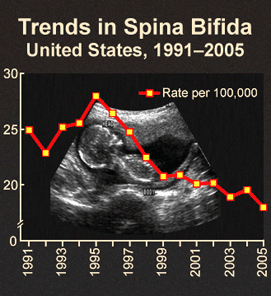Trends in Spina Bifida, United States, 1991 - 2005
Women of childbearing age: take at least 400 micrograms of folic acid daily to reduce neural tube defects like spina bifida.

In 1992, the U.S. Public Health Service recommended that women of childbearing age increase consumption of the vitamin folic acid to reduce spina bifida and anencephalus. In 1996, the U.S. Food and Drug Administration authorized that all enriched cereal grain products be fortified with folic acid. Optional fortification started in March 1996 and mandatory fortification in January 1998. Results from the National Health and Nutrition Examination Survey(NHANES) for 1999-2000 show that public health actions have been effective in increasing folate status among women of child-bearing age. However, results from 2001-2004 NHANES show that folate status among women of child-bearing age has since remained unchanged (MMWR, January 5, 2007).
Birth certificate data in the United States have been available for selected birth defects since 1989 from the National Vital Statistics System, a component of the Centers for Disease Control and Prevention (CDC), National Center for Health Statistics (NCHS). This Health e-stat provides a 15-year trend for two neural tube defects, spina bifida and anencephalus.
After a significant increase in the spina bifida rate from 1992 to 1995, there was a significant decline from 1995 to 1999. Although declines were not significant from 1999 to 2005, the rate for 2005, 17.96 per 100,000 live births, was the lowest ever reported.
Birth certificate data for 1991-2005 are final. For further information about the birth data file see Births: Final Data for 2005. The numbers and rates for all years exclude data for Maryland, New Mexico, and New York, which in various years had either incomplete reporting or did not report these neural tube defects. Both spina bifida and anencephalus are considered underreported on the birth certificate. CDC is continuing to monitor and analyze neural tube defect occurrence data.
References
CDC. Folate status in women of childbearing age, by race/ethnicity -- United States, 1999-2000, 2001-2002, and 2003-2004. MMWR 2007; 55:1377-80.
Martin JA, Hamilton BE, Sutton PD, Ventura SJ, et al. Births: Final data for 2005. National vital statistics reports; vol 56 no 6. Hyattsville, MD: National Center for Health Statistics. 2007
Data Source: CDC. Trends in Spina Bifida and Anencephalus in the United States, 1991-2005. 2007. Available from: http://www.cdc.gov/nchs/products/pubs/pubd/hestats/spine_anen.htm.
More Information

Folic Acid: Helping to Ensure a Healthy Pregnancy
![]() Listen To This Podcast…(5 minutes) in English or Spanish
Listen To This Podcast…(5 minutes) in English or Spanish

Know someone who is thinking about getting pregnant?
Send her this Health-e-Card from CDC

Know someone who is pregnant?
Send her this Health-e-Card from CDC


